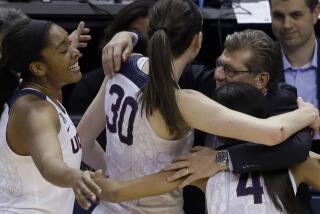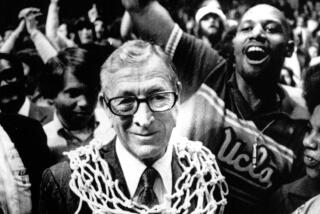NCAA update: How Duke and Kentucky prostitute themselves for sports

Kentucky head coach John Calipari, early in the game Saturday in which his Wildcats were knocked out of the NCAA championship by Wisconsin.
The University of Kentucky was knocked out of the NCAA men’s basketball championship by Wisconsin on Saturday, one victory shy of an undefeated record. The team will be watching from the sidelines when Wisconsin plays Duke for the national title Monday night.
But that hasn’t stilled the debate over the recruiting and operational strategies of Kentucky’s star head coach, John Calipari. He’s a paragon of the “one-and-done” school of college basketball, which imports promising high school players to campus to play out the one-year post-high school wait mandated by the National Basketball Assn. before they can enter the NBA’s pro draft. Three freshmen on this year’s Kentucky squad, including two starters, will be first-round picks if they enter the draft this year, according to analysts at DraftExpress.
UPDATE: Duke beat Wisconsin 68-63 for the national title, with three potential high draft-pick one-and-dones among its five starters: freshmen Justise Winslow, Jahlil Okafor, and Tyus Jones. In other words, take a bow, Coach Mike Krzyzewski, and stand over there next to Coach Calipari.
The meaning of Calipari’s success at getting his players into the high rounds of the NBA draft was aired in a serious and intelligent exchange in recent weeks between Albert Burnenko of Deadspin and A.J. McCarthy of Slate.
Burnenko dismissed the praise Calipari gets for putting “players first” (the title of his autobiography): Calipari, who gets paid $6.5 million a year while his players get paid nothing, is “profiting, immensely, off of a system that forces players to play college basketball if they want professional careers,” he wrote. “The players take all the risk, and he takes all the money.”
McCarthy responded that while Calipari is “no Robin Hood,” he’s not as bad as other NCAA coaches. “Calipari’s unmatched success in getting his players to the next level — while certainly not entirely ridding him of the NCAA’s stench — does, actually, separate him from his rival coaches. Not just in degree, but in kind as well.”
Burnenko got in the last word (so far) by reminding us that the unpaid year or two players spend with Calipari can potentially cost them millions — an injury can knock them down drastically in the draft, which has direct consequences on their potential NBA pay. “Only in the context of the NCAA would justice-minded people look at him — a millionaire management-class white dude who asks for a year of underpaid labor, rather than four, from his black teenage workers — and see a beacon of fairness.”
These are all sound points, but something is missing from the discussion: the role of the university. That’s typical of almost every iteration of the debate over the one-and-done rule — it’s treated as a conversation between the NBA and the National Basketball Players Assn., with college coaches weighing in here or there.
Almost never is there even a symbolic tip of the hat to the universities, which are expected to bring teenagers onto campus, pretend they’re on hand to study and graduate, and falsify their academic qualifications to get them there and their school records to keep them there. (For some examples of the inexcusable academic fraud this invites from university administrators, see our column on the issue here.)
Plainly, this arrangement benefits two parties: the NBA, which acquires players seasoned by a year of maturity and training under skilled coaches such as Calipari; and the coaches, who live on multimillion-dollar salaries.
What about the players? The usual argument that they get a scholarship-paid university education is hardly worth taking seriously when we’re talking about players who come to college with the express intention of bailing out after a year.
And the universities? They’re prostituting their academic standards on behalf of a system in which they claim to be powerless. Last April, NCAA President Mark Emmert said he was in “vocal opposition” to the one-year wait rule.
“As everyone knows here,” he said at his annual Final Four press conference, “this is enshrined in the labor agreement between the NBA and the NBA players, and not a rule that we have control over. ... I think everybody here knows my position on it.”
Has Emmert ever made a more ridiculous statement? The NCAA and its members schools have full control over their programs. They could require that all “scholar-athletes” on campus be scholars first and athletes second — no skipped classes, no fabricating of grades or papers, no scholarships reserved to the athletic department, and dismissal of any coach or sports personnel found violating the rule. (The punishment for Syracuse basketball coach Jim Boeheim, whose program engaged in 10 years of outright academic fraud, according to the NCAA? Three more years of employment, until his scheduled retirement.)
What “everybody knows” about the position of the NCAA and its member schools is that it’s dictated by money. The University of Kentucky men’s basketball program collected $23.7 million in revenue and spent $16.2 million in 2013-14, according to official disclosures, for a profit of $7.5 million. (Its football program was even more profitable.) But the cost to its academic reputation of running what is nothing more than a free finishing school for NBA prospects is surely much higher. And that’s Kentucky; many Division 1 football and basketball schools run their programs at a loss, despite all the cash flowing in.
We’ve reported before that some thoughtful university administrators believe that the only way for universities to avoid the corruption and absurdity that come from operating big-money quasi-pro sports programs is divestment. Let the NBA and National Football League run their own farm systems, instead of saddling universities with the task.
But you won’t find many such thoughtful souls in the athletics department. Instead, you get expert sophistry from the likes of John Calipari, who says he can’t understand why people are up in arms just because basketball players are “jumping at money” to join the NBA draft. After all, he writes in his book, “Neither Bill Gates nor Steve Jobs made it all the way through college.”
Really, Cal? You’re comparing a kid who comes onto campus with the advance intention of spending only a year — and only because he must — to a couple of entrepreneurs who made it to university based on their academic qualifications and once there discovered there was something else they’d rather do? Really?
Calipari is regarded as a truth-telling visionary because he tries to make the best of the system, with his eyes wide open. “We’re not keeping these NBA-quality players for four years,” he writes. “Those days are gone.”
He thinks one-and-done is a terrible burden. But it’s not as though he recognizes it for the exploitative scandal it is. He just thinks it’s a “problem” that “every year, I’ve got to go make a new team.”
His solution is for the NBA to stop making young players stay in college for one year. He thinks they should have to stay for two. That would sure make it easier on him.
Keep up to date with the Economy Hub. Follow @hiltzikm on Twitter, see our Facebook page, or email mhiltzik@latimes.com.
More to Read
Inside the business of entertainment
The Wide Shot brings you news, analysis and insights on everything from streaming wars to production — and what it all means for the future.
You may occasionally receive promotional content from the Los Angeles Times.











